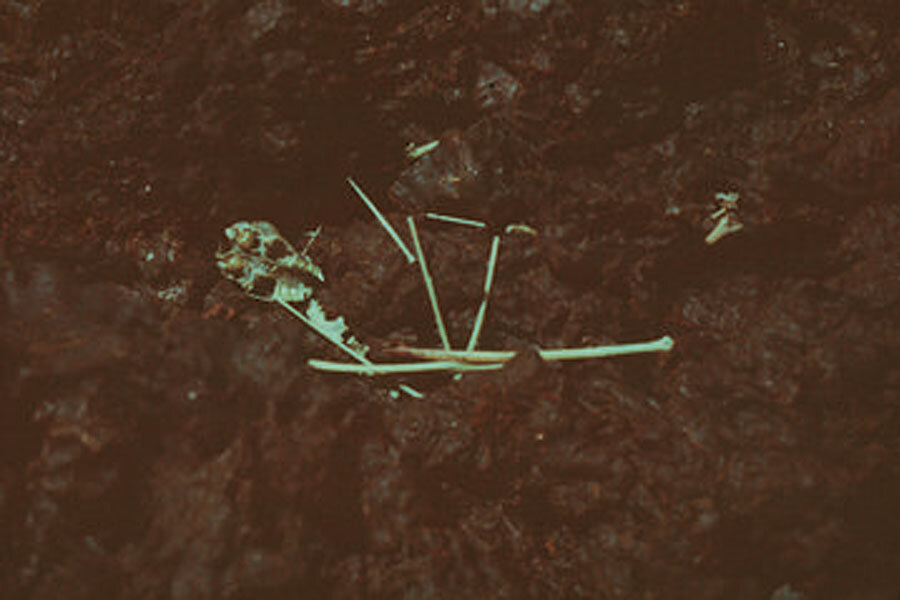Hawaii finds and loses a second native mammal
Loading...
According to a new study published this week in American Museum Novitiates, Hawaii has one more native land dwelling mammal than it thought it did. Or it would, if that mammal, a newly discovered species of bat, had not gone extinct eleven hundred years ago.
Today, Hawaii only has one living native land mammal in residence, another type of bat called the Hawaiian hoary bat. This new bat species, named Synemporion keana, lived alongside the hoary bat before it went extinct around 11,000 years ago.
This is a discovery 35 years in the making, according to study co-author Nancy Simmons. Her fellow author, Francis Howarth of the Bishop Museum in Hawaii, discovered skeletal remains of Synemporion keana while climbing through a lava tube in 1981.
Most bat skeletons that Dr. Howarth discovered on his explorations of Hawaii’s lava caves were on the floor, but the skeleton that he discovered in 1981 was embedded in the crystal structure of the lava cave, leading Howarth to believe it was very old.
Howarth, an entomologist, brought the fossilized bat remains to fellow Bishop Museum employee Alan Ziegler. “He immediately realized that it was something completely different,” said Howarth in a phone interview with The Christian Science Monitor.
The two men worked together on the project until Dr. Ziegler’s death in 2003 put the bat study on hold. Prior to his death, Ziegler had written a draft of the team’s research thus far. It is a completed version of Ziegler’s manuscript that the team published this week.
After Ziegler’s passing, Howarth brought Dr. Simmons, a bat expert at the American Museum of Natural History, into the study. Simmons looked over the manuscript that Ziegler had started many years before, and compared the bat skeletons that her colleagues had collected from several Hawaiian islands to the skeletons of other bats from around the world.
Simmons agreed with Ziegler’s initial assessment that the bat skeletons were something altogether new. “To a specialist,” Simmons told the Monitor by phone, “it is quite clear that they are very different from a hoary bat.”
The differences, Simmons says, lie in the shape and number of the bat’s teeth, the shape of its skull, and shape of several limbs.
“There were a lot of comparisons necessary to make sure that it was not a member of a current, living species,” Simmons told the Monitor. In fact, there were several similarities between different parts of the bat and other species around the world, but no other bat species was a perfect match for the one that Ziegler and Howarth discovered in the 1980s.
“It is a combination of traits,” says Simmons. “It is a mosaic of features that are different.” These differences led Howarth and Simmons to deem the bat its own species.
Although Howarth says that Simmons was eager to have the bat’s DNA extracted and analyzed, the team has not yet managed to extract the DNA.
They determined that it had inhabited the island for a long time, beginning at least 320,000 years ago. Researchers believe the bat went extinct about 1,100 years ago, around the time that humans began to inhabit the island, though Howarth says that the team has some undated skeletons that it believes may be more recent than that.
“It is even conceivable that it still inhabits some remote pocket of the islands,” Howarth told the Monitor, “but that’s pretty far out.”
When humans began to inhabit the island, they engaged in a variety of behavior that could have disrupted the bat populations, including clearing the land and otherwise rearranging the landscape, and introducing rats to the island.
“The suspicion is that it was the Polynesian rat that caused many of the extinctions,” Howarth told the Monitor.
Whatever the cause, the extinction of Synemporion keana left the Hawaiian hoary bats, which first came to the Hawaiian Islands around seven to ten thousand years ago, as the only native mammal species.
Hawaii is remarkably bereft of endemic species, with many of its initially endemic bird species having gone extinct, and no native reptiles or amphibians. Although there is one other mammal on the islands, the Hawaiian monk seal, it is an aquatic animal. Most of the island’s animal species were introduced by humans.
“It shows us that there was greater diversity in the past than there is today,” Simmons told the Monitor. “We are interested globally in the effects that humans have on the flora and the fauna of our world.”
Howarth agrees that it is important to understand the world around us. Regarding the bats, he says, “This discovery underscores the need for biologists to get out in the field and observe and document what they find.”








